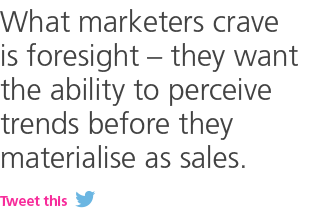 Marketers need sophisticated information which enables them to look to the future, not the past, says Rosie Hawkins, global head of brand and communication at TNS
Marketers need sophisticated information which enables them to look to the future, not the past, says Rosie Hawkins, global head of brand and communication at TNS
A constant complaint about market research is that it is backward looking. Consumer surveys take a few weeks to compile, so the data is always dated. If something drastic has happened in the intervening period, it’ll be missing.
This time-delay is more than annoying. It paralyses the marketing department’s ability to influence events.
Imagine a new ad campaign. Expectations are high. But the early signs are that something is wrong. The campaign isn’t generating much buzz and there is no sign of sales improving. Should the marketing team step in and change the campaign or ride out the blip and stay on message?
A survey will provide the answers, but it isn’t available now when the decision needs to be taken.
 What marketers crave is foresight – they want the ability to perceive trends before they materialise as sales. Then they can anticipate behaviour. Problems can be remedied before they develop.
What marketers crave is foresight – they want the ability to perceive trends before they materialise as sales. Then they can anticipate behaviour. Problems can be remedied before they develop.
Impossible? Not at all. Brand equity scores reveal how consumers feel about a product or company. The score helps marketers predict how consumers will behave. The only glitch is up to now the process had taken too long.
 To look into the future you need predictive brand equity scores. TNS is pioneering this switch The surveys for which we are known are being enhanced by modelled social media and search data, which accurately predicts brand equity months in advance of survey data.
To look into the future you need predictive brand equity scores. TNS is pioneering this switch The surveys for which we are known are being enhanced by modelled social media and search data, which accurately predicts brand equity months in advance of survey data.
Armed with this information the marketing team can foresee changes to sales before they happen. For example, in the event of an underperforming ad campaign, the marketers could use the score to identify an imminent fall in brand equity, foreshadowing further problems. Thus, they can intervene to turn the campaign around. Or, if the score is strong, stick with the current strategy.
The term “game-changer” gets used a lot in this industry, but in this case it’s spot on.
How are we doing it?
We scrape Twitter, Google+, Facebook, LinkedIn and other social networks, and combine that data with searches on Google, Yahoo! and Bing, and content from relevant blogs – for example, hair care blogs for hair care products – to get a complete overview of consumer opinion around an issue or a brand. We crunch the data to provide an easy-to-understand brand equity score, and rich and early insights to explain what is happening.

We use some sophisticated processes. We’ve all heard the concerns about the accuracy of social media. When a Twitter user mentions Apple do they mean the fruit or the iPhone manufacturer? Does “sick” mean good or bad? And how can the negative bias of internet commentary be factored in?
We work with a variety of specialists in the field of data-cleaning and modelling to refine the methodology. Our results have been tested against real-world outcomes and survey data, with an average of 90 per cent accuracy. As a footnote, it is cheaper to conduct than surveys, freeing up budget for other research.
Marketers can now summon a metric which is more cost effective and reliable with a potent power to predict future behaviour. It ushers in a new era in which marketers spend their time looking at prospective opportunities and pre-empting risks, not looking over their shoulders at past events they are powerless to influence.
It’s a powerful approach. The question now is how you are going to use it.
Rosie Hawkins
Global Head of Brand & Communication
+44 203 130 7319
@RosieHawkinsW
rosie.hawkins@tnsglobal.com









